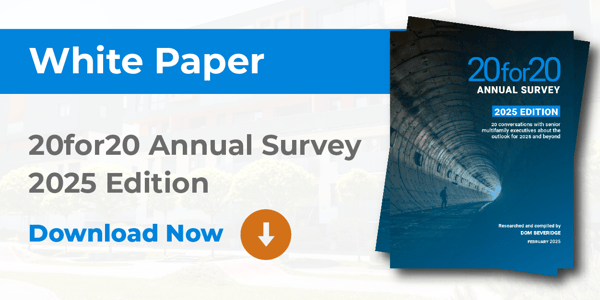
It's safe to say that technology is changing. There's more of it than ever before, and, as this year's 20for20 Annual Survey highlighted, "tech bloat" is a growing problem in multifamily operations. The topic came up repeatedly in conversations at the recent AIM conference and will probably continue to surface throughout the rest of the conference season.
The core of the issue is this: over the past few years, as venture capital has poured into real estate technology, more startups are being funded than ever before. That's good news, as more new ideas can become realities. But more companies also means more evaluations, trade-offs, and opportunities for suboptimal tech decisions.
Customer-facing tech demonstrates how multifamily tech stacks have been becoming increasingly incoherent. Of the 20 executives interviewed for this year's 20for20 Annual Survey, 19 agreed that most companies don't have a clear vision of what their customer journey is. The more tech companies add, the less sense it makes for customers (not to mention the property teams who have to learn how to use it).
Stop Starting With Tech
Companies that are good at tech tend to approach decisions from first principles. Tech is meant to automate processes and deliver operational improvements that would otherwise be out of reach. That means starting with the desired business outcomes and evaluating whether technology can help to achieve them. The trouble is too many evaluations begin with the technology, not the need.
Starting with the tech risks framing decision processes as beauty contests, where buyers compare competing products to see which is best. But that's becoming an increasingly unhelpful way to think about technology innovation. There are many reasons for that, but one of the most interesting has to do with the categories we use to classify technology.
How Categories Confuse Things
Over the last year, the 20for20 podcast has been digging into areas like fraud prevention and maintenance to understand business problems and tech solutions. Exploring categories can be enlightening, but when the category frames the evaluation process (as it does in the beauty contest scenario), buyers risk overlooking better solutions to their problems.
Multifamily tech increasingly overlaps conventional categories. For example, you can purchase maintenance capabilities from technology companies whose core business is not maintenance. You can purchase access control functionality from companies we would not normally associate with smart tech. As AI becomes more ubiquitous, we should expect to find more solutions that don't fit neatly into categories that we're used to.
I was recently reminded of this dynamic while listening to a great discussion about taxonomy—the scientific process that sorts all known living organisms into detailed categories. While taxonomy has undoubtedly helped us to understand biology, there are also ways in which it hinders our understanding. (Bear with me!) Species evolve in many different ways, and our categories make species more discreet than they really are. Nature, of course, does not respect the boundaries that humans create to help us make sense of it.
Thinking of tech in categories—maintenance tech, smart tech, AI, fraud prevention, etc.—may help us compare apps we may be shopping for or considering investing in. But if we think of technology from first principles, i.e., in terms of the processes we need to automate, categories can cloud our thinking.
The "intake" problem of maintenance (handling inbound work orders) is a good example of a capability that resides in several different types of technology. It is a maintenance problem, to be sure. But if our objective is to automate the gathering of information about service issues, we should think more broadly about how best to solve that problem.
That's not to diminish what maintenance solutions offer. But in a world where AI is lowering the barriers to entry across nearly every type of technology, category boundaries are becoming less and less helpful—AI does not respect categories any more than nature does. And neither should we.
I recently had a fascinating conversation with a technology leader who has a radically different vision for how to deliver property management technology. I won't name the vendor, but the ideas challenged several long-established technology categories in our industry. When you factor in the potential of AI-first technologies that operate across multiple domains, the idea of comparing products within fixed categories feels increasingly like an anachronism.
Tech bloat and how to avoid it is a topic that I'll be exploring in more depth on a panel at Blueprint later this year. In the meantime, I'll continue to share thoughts through the summer on what I believe is becoming an increasingly critical area of multifamily technology.
Photo by Florencia Viadana on Unsplash



